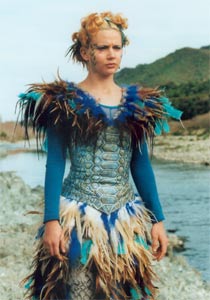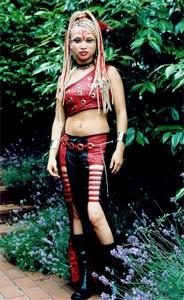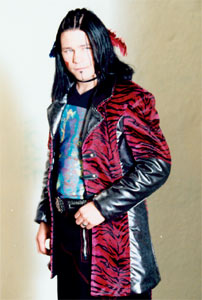 Ever wondered how Ebony gets her corset so red or where Lex finds enough black dye to colour his clothes?
Ever wondered how Ebony gets her corset so red or where Lex finds enough black dye to colour his clothes?
Natural dye of course – okay well maybe not, as we do have some wonderful wardrobe designers on the show but if Meryl and Caleb were thrown into the wild without wardrobe designers or shops then they would have to make their own clothes.
Nobody really wants to wear boring clothes and the beauty of The Tribe is that it is full of amazing costumes, some that we would never wear out and about but some that are definitely cool and could be adapted to make them more user friendly.
Check out the Tribestyle section to have a closer look at some of the costumes used on the show.
People have always wanted to individualize themselves, their culture or religion and this has been aided with the use of materials, designs and colour.
Of course the conditions in which people live are vitally important – some areas of the world have little use for clothes other than shorts and t-shirts whereas in other countries you would freeze if you stepped out of the house in less than a thousand layers of thermals. And some clothing does not have to be very multi – coloured if you need to camouflage yourself.
Fashion changes with each passing year and in 2005 in the western world we are seeing an amalgamation of different eras and fashions, where practically anything is deemed normal.
There has also been a resurgence in crochet and knitting lately; with many people making their own scarves, jumpers and ponchos. Some people are talented enough to make all their own clothes. And that is just what we all would have had to do in the past – unless we were rich and could afford our own dressmaker.
 In caveman times clothing was made by skinning an animal, drying the skin and holding it together with bones or teeth.
In caveman times clothing was made by skinning an animal, drying the skin and holding it together with bones or teeth.
As time went on, discoveries were made as to how to use threads and other fastenings and it is amazing if you look in a museum at how inventive people were when there was few materials at their disposal.
Ancient Egyptians, Chinese, Persians and Indians used colour in their clothing many centuries ago. Probably the oldest natural dye is indigo and one of the dyes used in ancient times was derived from a species of snail and known as Tyrian purple.
Italians took to dying their materials in the 13th and 14th centuries and the practice spread throughout Europe. More and more dyes were discovered and soon the world was awash with colour!
The first synthetic dyes (most dyes used in this day and age are synthetic) were made by W.H. Perkin and Adolf von Baeyer in the 19th century.
Natural dyes are obtained from animals and plants. Cochineal (a red dye) is actually made from the shells and bodies of beetles found in Mexico and Central America (the insects live on cacti)! This dye came over to Europe from Mexico and was widely used for many years as a wool dye and even as a food colouring!
There are many natural dyes that the Tribe could use if they did have to make their own clothes…
 Ochre – this is a yellow-brown colour obtained from mixing proportions of iron oxide and clay. The difference in iron oxide makes the colour different – some ochres are more red or brown.
Ochre – this is a yellow-brown colour obtained from mixing proportions of iron oxide and clay. The difference in iron oxide makes the colour different – some ochres are more red or brown.
Alizarin – an orange red dye, originally taken from the roots of the madder plant.
Indigo – blue dye that is taken from a variety of shrubs related to the pea family. Indigo (as we have mentioned) is one of the oldest natural dyes and has been found on the wrappings of mummies from the XVIII dynasty in Egypt.
Catechu – brown dyes made from the heartwood of the Acacia Catechu plants found in Asia. The brown can be adapted into olives or khakis as well as darker browns and yellowy-brown.
There are many more colours that are extracted or made from plants such as Chamomile, Marigold, Henna, Walnut, Pomegranate and Chestnut to name a few.
Making natural dyes can be a time consuming process with much soaking, crushing and macerating but it is what you would have to do if you wanted to add colour to your life in a world without shops or synthetic dye.
In fact, perhaps life in Tribeworld would not be as complicated as we have talked about above as there might well have been synthetic dyes left in the shopping mall or throughout the city?
Or judging by Ebony’s cochineal red corset, maybe there was an invasion of beetles…

